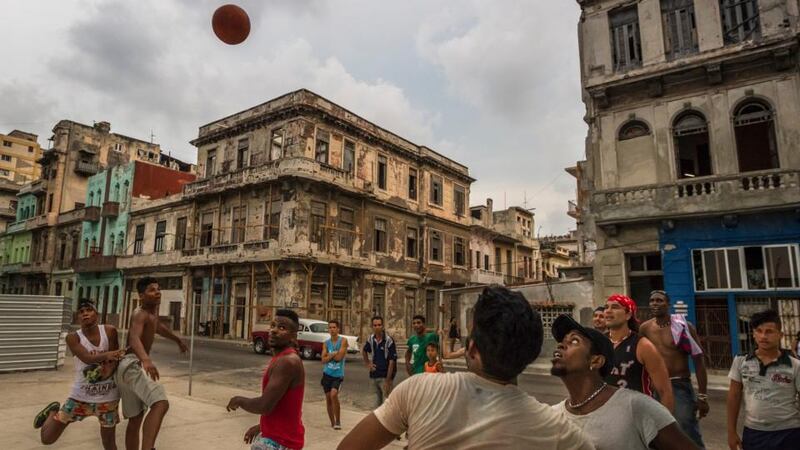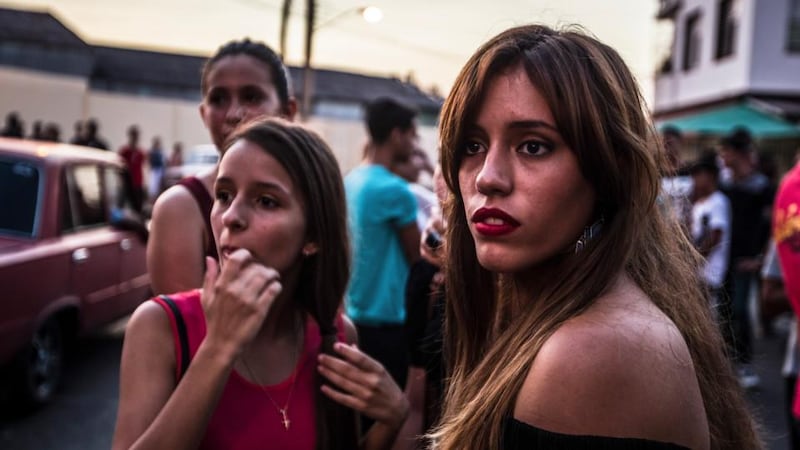Wedged between a construction site and the shells of once grand colonial homes, a basketball game was under way, the neighbourhood pouring into the rubble-strewn street for some evening entertainment. It was not much. A chewed concrete floor, a splintered backboard and a piece of bent rebar for a hoop. But as entertainment went, the price was right: No one paid a thing to enjoy the seaside air, the sunset or the game as they soaked up a snapshot of life seemingly preserved in time.
And that, to many in attendance, was precisely the problem. While the news media was buzzing about the new US embassy, which had reopened for the first time in more than 50 years, barely a word passed among the Cuban youths about the many changes afoot in their nation.
“Change? My life won’t change,” said Yunior Rodriguez Soto (17) posted by the court with a few friends. “I mean, look how we’re living, look how we are playing?” he said, pointing at the goal, which had been knocked askew. He paused. The ball zipped out of bounds and a friend raced to retrieve it. Change, in his mind, would come in spite of the government, not because of it. “They won’t let it happen,” he said, referring to the Cuban government. “It’s just how they are.”


Much has been made of the historic shift under way in Cuba, where the government is making strides to open the ailing economy to world markets and re-establish relations with the United States for the first time in half a century. For many, that has raised hope of a new prosperity.
But there is an air of cynicism among Cuban youths who see the ideals of Fidel Castro’s revolution as as dated as the battered cars that traverse Havana’s streets. Once so integral to life on the island, they are relics of a bygone era, removed from the economic imperatives that are driving the young to flee in record numbers.
As much as the young welcome political opening and economic reform, such changes are unlikely to filter down to their lives anytime soon. Measurable change will come slowly, stalled between the leadership’s desire for prosperity and its determination to maintain control.
Even with evidence of change in the streets of Havana – new clubs, bars and glimmering restaurants that rival those of more affluent Caribbean neighbours – life for many Cubans has barely improved. And that may well inform the Cuban authorities’ biggest challenge in coming years: managing expectations.
"So far, the only way to see change is to make a boat and sail off," said Dayán Roa Santana (20) a Cuban baseball player, who did just that in late December. On December 30th, about two weeks after the government announced that it would restore diplomatic relations with the United States, Roa Santana set sail for America on a rickety boat he built with a friend. After a few days at sea, he was captured by the US Coast Guard and sent back home, where he was forced to pay a heavy fine.
As soon as he can save up money for the next journey, he says, he will be gone. Cases like Roa Santana's are not new and officials are well aware they aggravate a demographic problem already undermining an economic overhaul. Unlike many developing nations, which enjoy large youth populations, Cuba resembles the graying communities of northern Europe or Japan, societies grappling with how to finance their old people without the engine of youth. Nearly 20 per cent of the Cuban population is over 60, making it the oldest in all of Latin America.
Officials and analysts say that economic change is part of a strategy to persuade young people to stay and have families, replacing a swollen public sector with more private jobs - a promise that has been slow to take shape. The government has for years tried to encourage more private sector development. Restaurants, nail salons and about 200 other approved businesses now employ nearly 400,000 people, according to government figures. Property reform has been enacted, and the tourism sector is booming, though without the infrastructure to support it.
But the government, struggling to balance economic growth with state control, often works at cross purposes. Small business owners are subjected to a byzantine structure with heavy government oversight, where free enterprise is often stifled by a state struggling with letting go.
Such realities are particularly galling for the newer generation of Cubans, such as Jose Luis Rodriguez Roig (24) who owns a private cafeteria with his father that sells pizzas, burgers and coffee. To buy flour, Rodriguez Roig says, the government prices are often too high to turn a profit. So he, like other Cubans, turns to the black market, a move that could land him in trouble. “There are tricks here and there, but the law isn’t going to change,” he explained, at a late-night party on the rooftop of a friend’s home in Havana.
A friend disagreed, arguing that the government was in the midst of changing, prompting a conversation taking place across the country now. “How can you not see?” his friend, Alejandro Rodriguez Zaldivar (30) who was hosting the party in his aunt’s home, insisted. “There’s an embassy and people are starting to think different. My grandfather’s generation was revolutionary. My father’s generation was less. This is the direction things are going.”
Rodriguez Roig shook his head and pulled on a cigarette. “You asked me what change do I see? Nothing,” he concluded, drawing his arm over the roofs of the low-slung houses toward the waterfront. “Just because there’s an embassy over there, it doesn’t change anything.” After 50 years of stasis, there is a desire among Cubans to see the fruits of this new era right away. And yet the government has said the pace of change will be slow.
"The reason it has taken so long is that the government only now finds it in their interest," said Yusbel Hernandez Campanioni, who was visiting the beach of Guanabo on a recent week day. "If it was up to the Cuban people, it would have happened a long time ago."
During the summer, youths often flock to the beaches near Havana, such as Playa Santa Maria, near Guanabo, which is about a 25-minute drive from the capital. Public transit there and back is less than 5 cents, an affordable outing for Cubans with little disposable income.
On a recent weekday, thousands of Cubans idled along the slender white sand strip, a coast of cerulean water. Arrayed in the sand, Campanioni and Yohendy Rodriguez Curreta sipped rum from the bottom half of a split beer can. Many summer days are spent like this, though the pair lucked out when Curreta’s cousin visiting from Mexico pitched them a free bottle of liquor.
“Otherwise, we would just be laying here,” said Curreta (21), who works as a janitor at a cultural centre for about $10 (€9.10) a month. For Curreta, salary was an issue. It was hard to afford the basics on his income, he said, no matter how hard he worked. “Here you consume based on what you can afford,” he said. “And this is what we can afford.”
“Everyone speaks revolutionary, but we live day to day,” interjected Campanioni. “We think about what we are going to do today, and tomorrow we will think about the next day.”
And yet Cuba is a different place from even a decade ago, with a budding set of high-end paladars, or private restaurants, where prices can rival more opulent tourist destinations in the Caribbean. More well-off teenagers have an array of options to choose from, including La Fábrica de Arte Cubano, a former peanut-oil factory that bears all the hallmarks of Brooklyn chic: exposed brick, industrial accents, even an old smokestack looming over the neighboring building.
The newly opened venue, a venture between a prominent Cuban musician and the state, is an example of what the government is aiming for, whether youths realize it or not. On a recent night, thousands of young people ages 12-18 gathered outside the building, awaiting entrance to a party. “We don’t really think about politics,” said Amalia Sanchez (17) standing with a throng of friends. “We just want to have fun.”
New York Times










